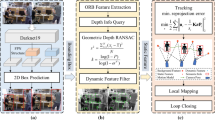Abstract
Wireless multimedia sensor networks (WMSN), with self-organizing and high fault tolerant characteristics, have achieved great advantages in target tracking region. However, the capabilities of these tiny devices are limited by their battery power, storage capacity, computational ability and communication bandwidth. In this paper, hybrid wireless multimedia sensors networks composed of acoustic and image sensors are proposed for target tracking. When the target appears in the detection area, it may change the environment parameters nearby, so acoustic sensors are used to gather target signal firstly. Then, a target location method is executed based on the strength of the received acoustic signal. Furthermore, to achieve energy-efficient target tracking with high reliability and robust, image sensors are used as supplements to the acoustic sensors. This approach also reduces the power consumption communication burden of the whole networks. In order to decrease the number of active nodes, Gauss Markov mobility model is also adopted to predict the target trajectory and minimize the tracking region with considering of vehicular kinematics. Simulation results verify that, compared with other algorithms, our scheme can reduce the energy consumption and improve tracking accuracy.

















Similar content being viewed by others
References
Cai J, Gu M (2015) Performance analysis of star topology wireless sensor networks based on IEEE 802.15.4[J]. Qinghua Daxue Xuebao/Journal of Tsinghua University 55(5):565–571
Carreno Jara E (2014) Multi-objective optimization by using evolutionary algorithms: the p-optimality criteria. IEEE Trans Evol Comput 18(2):167–179
Galluccio L, Milardo S (2015) Reprogramming wireless sensor networks by using SDN-WISE: a hands-on demo[C]. Proceedings of IEEE International Conference on Computer Communications, 19–20
GhasemiGol M (2015) Anomaly detection and foresight response strategy for wireless sensor networks [J], Wirel Netw 21(5):1425–1442
Gungor VC, Hancke GP (2009) Industrial wireless sensor networks: challenges, design principles, and technical approaches[J]. IEEE Trans Ind Electron 56(10):4258–4265
Joshi S, Boyd S (2009) Sensor Selection Via Convex Optimization[J]. IEEE Trans Signal Process 57(2):451–462
Kumari S, Khan MK, Atiquzzaman M (2015) User authentication schemes for wireless sensor networks[J] Ad Hoc Networks 27(4):159–194
Li M, Liu Y (2009) Underground coal mine monitoring with wireless sensor networks [J]. ACM Transactions on Sensor Networks 5(2):1–29
Liu M, Liu B, Wen Y (2013) An efficient data evacuation strategy for sensor networks in postdisaster applications [J]. Int J Distrib Sens Netw 9(1):1–12
Liu S, Kar S, Fardad M (2015) Sparsity-aware sensor collaboration for linear coherent estimation[J]. IEEE Trans Signal Process 63(10):2582–2596
Masazade E, Niu R, Varshney PK (2012) Dynamic Bit Allocation for Object Tracking in Wireless Sensor Networks[J]. IEEE Trans Signal Process 60(10):5048–5063
Miettinen K et al (2008) Lecture Notes Comput Sci 5252:1–26
Misra P, Kanhere S, Ostry D, Jha S (2010) Safety assurance and rescue communication systems in high-stress environments: a mining case study [J]. IEEE Commun Mag 5:1–8
Ngai EC-H (2016) On providing sink anonymity for wireless sensor networks[J], Security and Communication Networks 9(2): 77–86
Olfati-Saber R (2007) Distributed Kalman filtering for sensor networks. Proc. the 46th Conference on decision and control, 5492–5498
Sinopoli B, Schenato L, Franceschetti M (2004) Kalman filtering with intermittent observations[J]. IEEE Trans Autom Control 49(9):1453–1464
Tian J, Shi H, Zhou Y (2009) Routing Design of Wireless Sensor Networks in mine monitoring system[C]. In World Congress on Computer Science and Information Engineering 1:32–37
Wang C (2016) Dictionary based secure provenance compression for wireless sensor networks[J]. IEEE Trans Parallel Distrib Syst 27(2) 405–418,
Wang G, Ren Y, Li J (2012) Application based rate controllable TCP for high performance bulk data transfer. IEEE high performance computing and communication (HPCC), 34-45
Wang G, Wu Y, Dou K, Ren Y, Li J (2014) AppTCP: the design and evaluation of application-based TCP for e-VLBI in fast long distance networks. Futur Gener Comput Syst 39:67–74
Wang G, Ren Y, Li J (2014) An effective approach to alleviating the challenges of transmission control protocol. IET Commun 8(6):860–869
Wang G, Zhao Y, Huang J, Duan Q, Li J (2016) A K-means-based network partition algorithm for controller placement in software defined network. International Conference on communications (ICC)
Xiao S, Xu Z (2016) Reliable and energy efficient communication algorithm in hierarchical wireless sensor networks. Wirel Pers Commun. doi:10.1007/s11277-016-3705-y
Zhang W, Cao G (2004) Optimizing tree reconfiguration for mobile target tracking in sensor networks[C]. Processing of IEEE International Conference on Computer Communications, 719–730
Zhu Y, Liu Y, Ni LM (2007) Low-power distributed event detection in wireless sensor networks[C]. Proc IEEE Int Conf Comput Commun 2401-2405
Zuo L, Niu R, Varshney PK (2007) Posterior CRLB based sensor selection for target tracking in sensor networks[C]. Processing of IEEE international Conference on acoustics 1041-1044
Acknowledgements
Foundation item: The Fundamental Research Funds for the Central Universities (2015XKMS087).
Author information
Authors and Affiliations
Corresponding author
Rights and permissions
About this article
Cite this article
Xiao, S., Li, W., Jiang, H. et al. Trajectroy prediction for target tracking using acoustic and image hybrid wireless multimedia sensors networks. Multimed Tools Appl 77, 12003–12022 (2018). https://doi.org/10.1007/s11042-017-4846-z
Received:
Revised:
Accepted:
Published:
Issue Date:
DOI: https://doi.org/10.1007/s11042-017-4846-z




